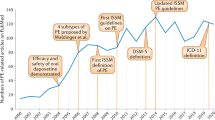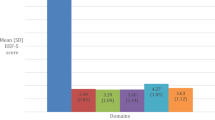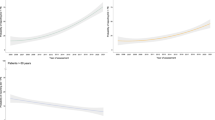Abstract
The traditional distinction between organic and psychogenic erectile dysfunction (ED) was maintained in the recent report of the Nomenclature Committee of the International Society for Sexual and Impotence Research. Among the major problems with this distinction are that it is based on an obsolete view of mind–body distinctions, does not take into account knowledge of the neurobiology of ‘psychological’ disorders, disregards the fundamental meaning of ‘psychosomatic,’ is too often diagnosed by exclusion, and may imply to the patient that his ED is ‘all in the mind.’ As a result, the distinction has become counterproductive in the diagnosis, classification, and treatment of ED, and in research into the causes of ED. An alternative taxonomy, based on that proposed by the Nomenclature Committee, reclassifies as organic several of the causes of ED now considered to be psychogenic, and considers others as situational ED, a class reserved for episodic occurrences of ED clearly due to particular attributes of sexual encounters.
This is a preview of subscription content, access via your institution
Access options
Subscribe to this journal
Receive 8 print issues and online access
$259.00 per year
only $32.38 per issue
Buy this article
- Purchase on Springer Link
- Instant access to full article PDF
Prices may be subject to local taxes which are calculated during checkout

Similar content being viewed by others
References
Diagnostic and Statistical Manual of Mental Disorders, 4th edn (DSM-IV). American Psychiatric Association: Washington, DC, 1994.
Silberstein SD, Lipton RB, Dalessio DJ (eds). Wolffs Headache and Other Head Pain, 7th edn. Oxford University Press: New York, 2001.
Lizza EF, Rosen RC . Definition and classification of erectile dysfunction: report of the Nomenclature Committee of the International Society for Impotence Research. Int J Impot Res 1999; 11: 141–143.
Rosen RC, personal communication, October 2000.
Symposium on Taxonomy of Erectile Dysfunction. 9th World Meeting on Impotence Research, Perth, Australia. November 26–30, 2000.
Searle JR . Consciousness. Annu Rev Neurosci 2000; 23: 557–578.
Stuss DT, Levine B . Adult clinical neuropsychology: lessons from studies of the frontal lobes. Annu Rev Psychol 2002; 53: 401–433.
Bancroft J . Central inhibition of sexual response in the male: a theoretical perspective. Neurosci Biobehav Rev 1999; 23: 321–330.
Giuliano F, Rampin O . Central neural regulation of penile erection. Neurosci Biobehav Rev 2000; 24: 517–533.
Heaton JPW . Central neuropharmacological agents and mechanisms in erectile dysfunction: the role of dopamine. Neurosci Biobehav Rev 2000; 24: 561–569.
Sachs BD . Contextual approaches to the physiology and classification of erectile function, erectile dysfunction, and sexual arousal. Neurosci Biobehav Rev 2000; 24: 541–560.
Davidson RJ, Abercrombie H, Nitschke JB, Putnam K . Regional brain function, emotion and disorders of emotion. Curr Opin Neurobiol 1999; 9: 228–234.
Cowan WM, Harter DH, Kandel ER . The emergence of modern neuroscience: some implications for neurology and psychiatry. Annu Rev Neurosci 2000; 23: 343–391.
Davidson RJ, Pizzagalli D, Nitschke JB, Putnam K . Depression: perspectives from affective neuroscience. Annu Rev Psychol 2002; 53: 545–574.
Grasby PM . Imaging strategies in depression. J Psychopharmacol 1999; 13: 346–351.
McEwen BS . The neurobiology of stress: from serendipity to clinical relevance. Brain Res 2000; 886: 172–189.
Ninan PT . The functional anatomy, neurochemistry, and pharmacology of anxiety. J Clin Psychiatry 1999; 60(Suppl 22): 12–17.
Nutt DJ, Glue P, Lawson C . The neurochemistry of anxiety: an update. Prog Neuropsychopharmacol Biol Psychiatry 1990; 14: 737–752.
Lue TF . Erectile dysfunction. N Engl J Med 2000; 342: 1802–1813.
Brock GB, Lue TF . Drug-induced male sexual dysfunction. An update. Drug Safety 1993; 8: 414–426.
Rowland DL, Greenleaf WJ, Dorfman LJ, Davidson JM . Aging and sexual function in men. Arch Sex Behav 1993; 22: 545–557.
Schiavi RC, Rehman J . Sexuality and aging. Urol Clin North Am 1995; 22: 711–726.
Wespes E . Erectile dysfunction in the ageing man. Curr Opin Urol 2000; 10: 625–628.
Stevens JC, Cain WS . Changes in taste and flavor in aging. Crit Rev Food Sci Nutr 1993; 33: 27–37.
Rolls BJ . Do chemosensory changes influence food intake in the elderly? Physiol Behav 1999; 66: 193–197.
Bancroft J . Central inhibition of sexual response in the male: a theoretical perspective. Neurosci Biobehav Rev 1999; 23: 763–784.
Bancroft J, Janssen E . The dual control model of male sexual response: a theoretical approach to centrally mediated erectile dysfunction. Neurosci Biobehav Rev 2000; 24: 571–579.
Bancroft J, Janssen E . Psychogenic erectile dysfunction in the era of pharmacotherapy: a theoretical approach. In: Mulcahy J (ed). Male Sexual Function: A Guide to Clinical Management. Totowa, NJ: Humana Press, 2001, pp 79–89.
Dalessio DJ . Remembrances of Dr. Harold G. Wolff. In: Silberstein SD, Lipton RB, Dalessio DJ (eds). Wolff's Headache and Other Head Pain, 7th Edition. Oxford University Press: New York, 2001, pp 3–5.
Cranston-Cuebas MA, Barlow DH, Mitchell W, Athanasiou R . Differential effects of a misattribution manipulation on sexually functional and dysfunctional men. J Abnorm Psychol 1993; 102: 525–533.
Bancroft J, Malone N . The clinical assessment of erectile dysfunction: a comparison of nocturnal penile tumescence and intracavernosal injections. Int J Impot Res 1995; 7: 123–130.
Broderick GA . Evidence based assessment of erectile dysfunction. Int J Impot Res 1998; 10(Suppl 2): S64–S73.
Thase ME, Reynolds CF, Jennings JR, Frank E, Howell JR, Houck PR, Berman S, Kupfer DJ . Nocturnal penile tumescence is diminished in depressed men. Biol Psychiatry 1998; 24: 33–46.
Meisler AW, Carey MP . A critical reevaluation of nocturnal penile tumescence monitoring in the diagnosis of erectile dysfunction. J Nerv Ment Dis 1990; 178: 78–89.
Schmidt MH, Valatx JL, Sakai K, Fort P, Jouvet M . Role of the lateral preoptic area in sleep-related erectile mechanisms and sleep generation in the rat. J Neurosci 2000; 20: 6640–6647.
Schwartz JM, Stoessel PW, Baxter Jr LR, Martin KM, Phelps ME . Systematic changes in central glucose metabolic rate after successful behavior modification treatment of obsessive-compulsive disorder. Arch Gen Psychiatry 1996; 53: 109–113.
Althof SE, Levine SB, Corty EW, Risen CB, Stern EB, Kurit DM . A double-blind crossover trial of clomipramine for rapid ejaculation in 15 couples. J Clin Psychiatry 1995; 56: 402–407.
Strassberg DS, de Gouveia Brazao CA, Rowland DL, Tan P, Slob AK . Clomipramine in the treatment of rapid (premature) ejaculation. J Sex Marital Ther 1999; 25: 89–101.
Carter CS, DeVries AC, Getz LL . Physiological substrates of mammalian monogamy: the prairie vole model. Neurosci Biobehav Rev 1995; 19: 303–314.
Acknowledgements
This paper is dedicated to Julian M Davidson, 15 April 1931–31 December 2001, in fond memory. Some of the ideas presented here appeared first in an earlier article (Sachs 11) and were presented at a symposium at the 9th World Meeting on Impotence Research, Perth, Australia, 26–30 November 2000. An abstract of this paper appeared on 14 June 2002 as a guest editorial in the on-line newsletter UroHealth (http://www.urohealth.org/editorials).
Author information
Authors and Affiliations
Corresponding author
Rights and permissions
About this article
Cite this article
Sachs, B. The false organic–psychogenic distinction and related problems in the classification of erectile dysfunction. Int J Impot Res 15, 72–78 (2003). https://doi.org/10.1038/sj.ijir.3900952
Received:
Accepted:
Published:
Issue Date:
DOI: https://doi.org/10.1038/sj.ijir.3900952
Keywords
This article is cited by
-
High incidence of sexual dysfunction and timed intercourse was found only in infertile males who with known impairment of sperm quality for a long period: evidence from a hospital-based cross-sectional study
Reproductive Biology and Endocrinology (2022)
-
Prevalence of sexual dysfunction among the male populations who seeking medical care for infertility, pregnancy loss and preconception care: a cross-sectional study
Scientific Reports (2022)
-
The Challenge of Erectile Dysfunction Management in the Young Man
Current Urology Reports (2015)



